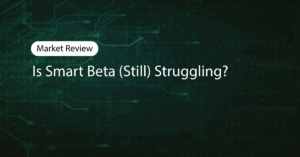Reading the ESG Label Before Use is Not EnoughMarket Review | January 2025
Introduction
In the previous edition of our Market Reviews we highlighted the importance of examining the holdings of a portfolio rather than relying on ESG labels to make a precise sustainability assessment. We observed a significant dispersion of “do no harm” (DNH) sustainability levels across our pool of collective investment schemes, with some ESG funds/ETFs showing no improvement (and sometimes a worsening) compared to their corresponding market cap-weighted benchmark. We also insisted on the potential financial consequences of pursuing a sustainable strategy. This led us to report that some funds seemed to be more efficient than others when managing the tradeoff between sustainability and financial risk and return.
Key takeaways:
- By using the concept of “Do No Harm” (DNH) we conducted a holdings-based sustainability review of a large universe of approximately 170 broad-based large cap indices ETFs invested in developed markets.
- First, we identified the Sustainable Development Goals (SDGs) most frequently “harmed” by the holdings of the indices, namely SDG 3 (Good Health and Well Being), SDG 16 (Peace, Justice and Strong Institutions), SDG 14 (Life Below Water), and SDG 8 (Decent Work and Economic Growth), but noted that the latter two appear to be overlooked by the negative screens commonly implemented in the institutional equity investment space.
- Next, we focused on and ranked a subset of 85 “ESG-labelled” indices using the same DNH approach, observing that they were on average more sustainable than their corresponding market cap weighted (CW) benchmarks. However, our analysis also uncovered a very large dispersion across the pool of benchmarks, with some ESG indices showing no significant improvement in terms of DNH-sustainability compared to the CW benchmark, prompting us to recommend sustainable investors examine the holdings of a portfolio and go beyond simple ESG labels.
- Finally, we examined the extent to which ESG-labelled indices had efficiently managed the financial risk and return consequences of pursuing a sustainable strategy. We identified, using a simple portfolio optimisation technique, potentially significant efficiency gains that can be interpreted as “sustainability-low-hanging-fruits” that some ESG indices have not picked.
Authors
Matteo Bagnara, PhD
Quant Researcher,
Scientific Portfolio ……………………………………….
Deputy CEO and Business Development Director,
Scientific Portfolio
Read the full Market Review
"*" indicates required fields


